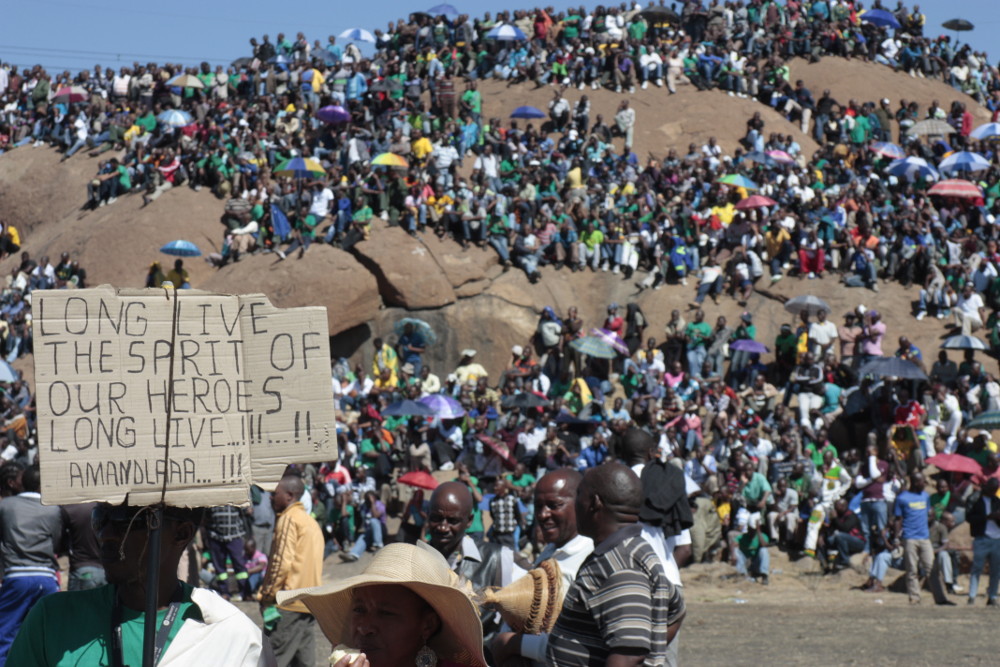On August 16, the anniversary of the police massacre on striking workers at the Lonmin platinum mine in Marikana, over 5000 mineworkers gathered on ‘the mountain’ where their comrades were shot down a year ago.
The hardest thing is that I don’t know why I survived… when nothing has changed, said one of the survivors who was one in the group that was mowed down in front of TV cameras. He was shot with 14 bullets and lay in a coma for two months.
Family members of the murdered workers spoke of their loss and pain. The ANC-government, which sent no representative to the commemoration, is at the time of writing rubbing salt in the wounds by rendering the commission of inquiry it instituted ‘to find the truth’ a complete farce by refusing to cover the cost of legal representation of the mineworkers’ families.
The Lonmin workers’ strike leaders spoke of the struggle the still face as the company tries to take back with the right hand the unprecedented wage increases it conceded a month after the massacre. Though Friday was a working day, thousands of Lonmin workers chose to sacrifice a day’s wages to pay their respects to their fallen comrades. Workers from throughout the Rustenburg platinum and chrome shafts also made their way to Marikana, as well as workers from Limpopo and Gauteng mines. They included workers from the three Amplats shafts in Rustenburg which were closed down on the very same day. Amplats, the world’s largest platinum producer, is imposing a massive cuts programme on the workers who were at the heart of the solidarity strike which followed the massacre and was decisive in turning the Lonmin strike towards a workers’ victory. Also present were workers from the Glencore-Xstrata mine in Tubatse, Limpopo, who were dismissed for taking strike action against the racist abuse they suffer in the mine in May. Fittingly, workers were therefore coming together on the margins of the rally to begin to work out a fight-back strategy against the bosses’ offensive which is now gathering speed.
The organisers of the commemoration rally were the Democratic Left Front-linked Marikana Support Campaign behind a front of conveners, namely Bishop Jo Seoka, who supported the strike, Advocate Dali Mpofu who represents the workers’ families at the Farlam Commission of Inquiry and Joseph Mathunjwa, the president of the workers’ new union AMCU. The event was conceived of as an all-inclusive ‘apolitical’ commemoration. The rally started off with an hour of prayers and contributions from religious leaders. Local kings and the Lonmin CEO were among the other speakers to be given a platform. All political parties, except for the Workers and Socialist Party which was formed by the Democratic Socialist Movement and mineworkers’ strike committees following the strike movement, had been invited to participate. All but the ruling ANC showed up, and were given a platform on the stage which had been sponsored by Lonmin. The Workers’ and Socialist Party however managed to push for a platform and Liv Shange eventually got to address the rally last, after a long list of right-wing politicians such as the Democratic Alliance to the Inkatha Freedom Party had poured crocodile tears, and after Julius Malema, the expelled ANC Youth League president-turned-‘Commander-in-Chief’ of the new Economic Freedom Fighters.
Malema’s speech was kept for last as a grande finale, and his sharp attack on the Lonmin management and the Zuma-government as responsible for the massacre was met with great enthusiasm by the workers. The attempt to again exclude WASP from the speakers’ list backfired when Liv Shange got to make the final speech after Malema, and was met with an equally warm welcome.
A year after applauding the massacre, the NUM and all other ANC-aligned structures were absent from the commemoration, which was condemned by the ANC in the North West province. NUM has just lost a long battle it fought by means of fraud, intimidation and court action to retain its recognition at Lonmin despite having lost nearly all its members to AMCU, which now has majority organising rights at Lonmin. A heavy police presence kept at a distance from the mountain.
A year after the massacre, the rally displayed the undeterred fighting spirit of the mineworkers. Despite the rather confusing circumstances of the rally – e.g. the involvement of the Lonmin bosses, and the political parties which despite their sweet talk represent the very ruling class which in effect ordered the Marikana hit – the level of class consciousness which Marikana registered in the minds of not only the Lonmin workers but of working class people across SA was also clear. It is an urgent necessity for mineworkers to once again come together as they did after the massacre, this time to respond to the onslaught on mining jobs and on their newly-recovered independent fighting capacity which the bosses have engaged in since the strike wave subsided. The willingness to give all the political parties an audience indicated the keen search for a political alternative. The battles that lie ahead centred on the mining industry will put to the test all those who claim to stand on the side of the workers. The reception the Workers and Socialist Party and the DSM received, including a record-high sale of the DSM paper Izwi labasebenzi and WASP t-shirts, show the confidence that the DSM has established for WASP among the mineworkers. WASP will certainly play a key role in the fight-back that must be driven by the mineworkers reaching out for support to other workers and struggling working class communities.

